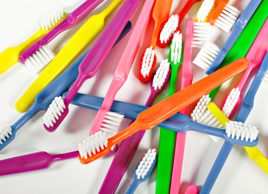Dos and don’ts of choosing the right toothbrush
Confused by the toothbrush aisle? Follow these tips to choose the right toothbrush for your needs

How do you choose your toothbrush? Perhaps you have a steady fave bought out of habit, or maybe you’re always on the lookout for a sale, jumping from toothbrush to toothbrush when the price is right. Or you choose according to aesthetics, considering the handle’s colour before any other attributes. All of these strategies will get you a toothbrush, but none gets you the best one for the job. Brush up on the dos and don’ts of picking the right toothbrush.
Do go for soft bristles
The Canadian Dental Association says to use a toothbrush with soft, rounded bristles. Go gently, too. You may have a penchant for scrubbing your teeth with a stiff-bristle toothbrush; however, this habit can be tough on teeth and gums. A survey of 700 dentists found that brushing teeth too hard was a leading cause of sensitive teeth, reports WebMD.
Do find the right toothbrush head
Consider the toothbrush’s head shape when selecting your tool of choice. Some toothbrush shapes will suit some mouths better than others. Make sure that your toothbrush bristles comfortably reach your backmost molars, as some brushes may be too large or wide. Try flossing and brushing in front of the mirror to make sure you cover every tooth, which is also a good way of visually checking that your toothbrush head is indeed reaching every surface. If it doesn’t, swap it for one that does.
Don’t buy no-name dollar-store toothbrushes
Five no-name toothbrushes in a package may seem like a steal at a handful of pennies each, but consider the risks. The product could be from a manufacturer who doesn’t care about safety or efficacy. The toothbrushes could be made of inferior or even unsafe materials. Seeing as you put a toothbrush in your mouth two or more times per day, it’s worth going with a reputable manufacturer. Leave the cheap ones on the shelf; they’re better suited for cleaning grout than oral hygiene.
Do get the right-size toothbrush for younger family members
Babies need baby toothbrushes because of their tiny mouths, so it also stands to reason that small children need toothbrushes with smaller heads than adult versions. Instead of promising a small toy or sugary treat to reward good behaviour at the supermarket or drugstore, let kids choose a new toothbrush with fun colours and graphics from the oral hygiene aisle. And don’t forget to replace their toothbrushes every three months when you replace your own, or possibly more often if they are hard on their brushes.
Don’t be reluctant to try powered toothbrushes
You might be a diehard manual toothbrush user, but if you’re not brushing as long or as thoroughly as you used to for reasons ranging from injury to arthritis, consider switching. ‘Both manual and powered toothbrushes can effectively and thoroughly clean teeth,’ says an article in the Journal of American Dentistry. ‘People who have difficulty using a manual toothbrush may find a powered toothbrush easier or more comfortable to use.’ Kids who have developed an aversion to oral hygiene might be persuaded to brush up with a fun new powered model, as well.
Do remember the basics
At the end of the day, the best toothbrush is the one you’ll actually use. That means the toothbrush handle should fit comfortably in your hand and the toothbrush head should feel comfortable in your mouth and be able to reach every tooth surface. And if you can’t remember the last time you changed your toothbrush, it’s probably time for a new one.




